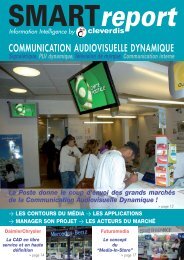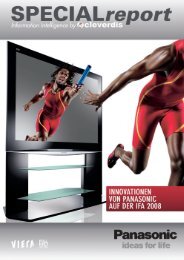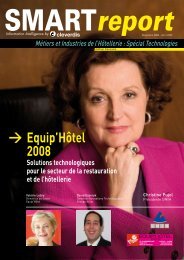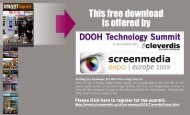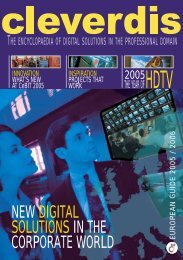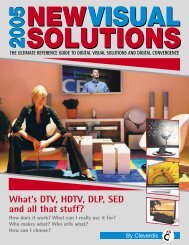Out-of-Home Digital Media are - Cleverdis
Out-of-Home Digital Media are - Cleverdis
Out-of-Home Digital Media are - Cleverdis
You also want an ePaper? Increase the reach of your titles
YUMPU automatically turns print PDFs into web optimized ePapers that Google loves.
© Photos: ScreenRed<br />
chips came along, but basically this was<br />
just a better quality version <strong>of</strong> MPEG1.<br />
Atari consoles change the face <strong>of</strong> digital<br />
signage: We started seeing early s<strong>of</strong>tw<strong>are</strong><br />
solutions at the time the Atari games console<br />
came out, because it had 3D graphics...<br />
But when this moved to the PC, it was<br />
always a bit tricky because PCs and their<br />
operating systems weren’t very stable,<br />
meaning you always had to write your<br />
s<strong>of</strong>tw<strong>are</strong> player for specific hardw<strong>are</strong> and<br />
graphics cards. By the time you did this, the<br />
graphics cards weren’t made any more, so<br />
it became a vicious circle. Finally, around<br />
the time <strong>of</strong> the release <strong>of</strong> NT4 and<br />
Windows 2000, s<strong>of</strong>tw<strong>are</strong>-based solutions<br />
started becoming more stable and we<br />
started standardising all the drivers.<br />
XP – The Quantum Leap: When XP came<br />
along, it was the jump that made PCs much<br />
more easy to use because the hardw<strong>are</strong><br />
became so much more stable. We can buy<br />
any system <strong>of</strong>f the shelf now and make our<br />
system work on it. I can’t remember the last<br />
time we had a hardw<strong>are</strong> conflict <strong>of</strong> any<br />
sort.<br />
www.cleverdis.com<br />
More bandwidth – smaller files: Over all<br />
this time, bandwidth has become cheaper<br />
and cheaper. There’s more <strong>of</strong> it and it’s<br />
become more stable. Delivery mechanisms<br />
have become so much cheaper as well,<br />
and we no longer have to use satellite<br />
delivery. The strange thing is that with recent<br />
video and graphics codecs like WMV9<br />
and Flash, all the content is getting smaller,<br />
so we have more bandwidth but less need<br />
for it! This makes it very easy to run a system<br />
over a network now.<br />
Current state <strong>of</strong> affairs: Today we have<br />
stable, cheap players, some <strong>of</strong> which use<br />
only video, and some use technologies like<br />
Flash as well... but what’s lacking is the<br />
experience <strong>of</strong> running large networks.<br />
Anyone can make a player, because it’s<br />
reasonably easy to play one piece <strong>of</strong><br />
content followed by another and another...<br />
but the difficulty is in the “head-end” where<br />
you programme the systems to govern<br />
what’s going to play and where. When we<br />
made our first system in 1990, it was a<br />
group-based system that allowed us to<br />
separate content that went to the south from<br />
that which went to the north and so on. We<br />
very quickly realised this wasn’t perfect,<br />
PART 1• <strong>Out</strong> <strong>of</strong> <strong>Home</strong> <strong>Digital</strong> <strong>Media</strong> Applications<br />
because a marketing person might, for<br />
example, want one type <strong>of</strong> content to go to<br />
all their malls that have an ice cream bar in<br />
them, which we didn’t have a group for. So<br />
that’s why we developed our system to be<br />
able to do what it does. I have seen 200<br />
site networks that have ten people working<br />
12 hours a day just updating content<br />
because the system is inefficient and based<br />
on simple groups, whereas today, we never<br />
have to use more than two people, and we<br />
can localise content very easily. Some very<br />
large companies have great delivery<br />
solutions or player solutions, but they realise<br />
we have a system “in the middle” that<br />
allows you to use those systems. Without<br />
this, what happens is that people <strong>of</strong>ten say<br />
‘this is too difficult’ and they simplify what<br />
they send out. The content thus becomes<br />
boring and people don’t watch it... and<br />
advertisers don’t pay for it. It becomes a<br />
vicious circle! So that’s where we have a<br />
real asset at ScreenRed, having more<br />
experience and s<strong>of</strong>tw<strong>are</strong> that drives the<br />
systems in such a way that we can<br />
individualise content for each site based on<br />
its characteristics.<br />
Improving on a good thing: Even a system<br />
like this can be improved upon, with local<br />
particularities affecting what’s played.<br />
Feedback from devices around the store...<br />
like “footfall counters”, people answering<br />
questions and other store data (what’s been<br />
sold and what hasn’t been sold) can be<br />
collected at a central site. For marketers it’s<br />
like a window on their retail network where<br />
they can see what’s working and what isn’t<br />
and make instant changes. It’s taking the<br />
guesswork out <strong>of</strong> marketing in real time,<br />
meaning marketers don’t have to try<br />
something and wait three weeks to see<br />
whether it will succeed... just to discover<br />
they’ve just wasted three weeks and it’s just<br />
not going to work!<br />
Interview Extracted from <strong>Cleverdis</strong><br />
SPECIALreport “The Fine<br />
Art <strong>of</strong> Retail Marketing”<br />
sponsored by ScreenRed.<br />
For further information on<br />
ScreenRed and their<br />
unique <strong>Out</strong> <strong>of</strong> <strong>Home</strong><br />
<strong>Digital</strong> <strong>Media</strong><br />
solutions, pick up a<br />
copy <strong>of</strong> the<br />
SPECIALreport at the<br />
ISE 2008 or<br />
ScreenExpo 2008 or<br />
download the PDF<br />
version at<br />
www.cleverdis.com<br />
<strong>Out</strong> <strong>of</strong> <strong>Home</strong> <strong>Digital</strong> <strong>Media</strong> SMARTreport January-July 2008 / 7



